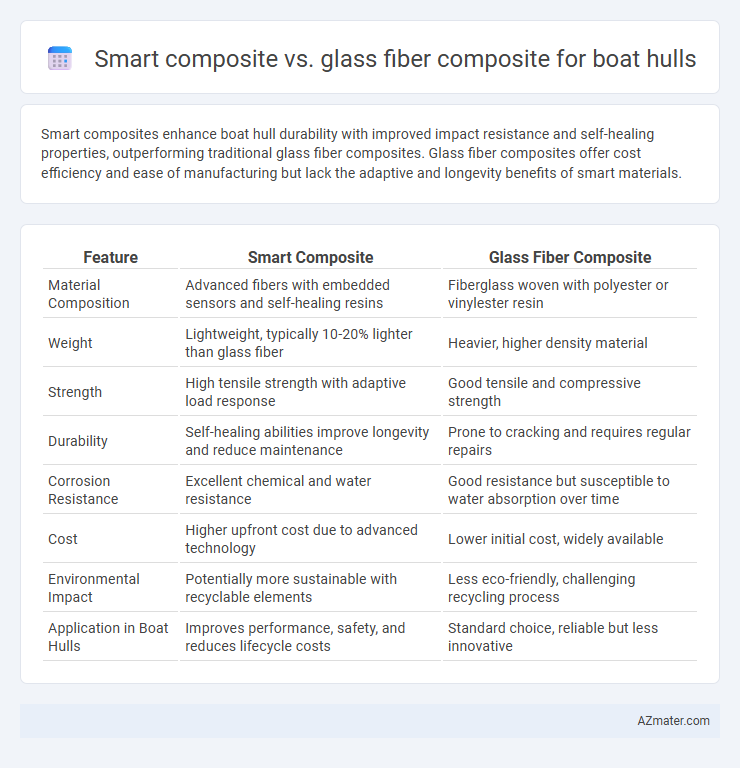Smart composites enhance boat hull durability with improved impact resistance and self-healing properties, outperforming traditional glass fiber composites. Glass fiber composites offer cost efficiency and ease of manufacturing but lack the adaptive and longevity benefits of smart materials.
Table of Comparison
| Feature | Smart Composite | Glass Fiber Composite |
|---|---|---|
| Material Composition | Advanced fibers with embedded sensors and self-healing resins | Fiberglass woven with polyester or vinylester resin |
| Weight | Lightweight, typically 10-20% lighter than glass fiber | Heavier, higher density material |
| Strength | High tensile strength with adaptive load response | Good tensile and compressive strength |
| Durability | Self-healing abilities improve longevity and reduce maintenance | Prone to cracking and requires regular repairs |
| Corrosion Resistance | Excellent chemical and water resistance | Good resistance but susceptible to water absorption over time |
| Cost | Higher upfront cost due to advanced technology | Lower initial cost, widely available |
| Environmental Impact | Potentially more sustainable with recyclable elements | Less eco-friendly, challenging recycling process |
| Application in Boat Hulls | Improves performance, safety, and reduces lifecycle costs | Standard choice, reliable but less innovative |
Introduction to Boat Hull Materials
Smart composite materials for boat hulls integrate advanced fibers like carbon or aramid with responsive resins, providing enhanced strength, impact resistance, and adaptability compared to traditional composites. Glass fiber composites, widely used in marine construction, offer cost-effective durability and corrosion resistance but lack the adaptive properties of smart composites. Selection depends on performance requirements, with smart composites enabling lighter, stronger hulls for high-performance vessels, while glass fiber remains preferred for economical and robust applications.
Overview of Smart Composite Technology
Smart composite technology integrates advanced materials such as carbon nanotubes or piezoelectric fibers within traditional composites like fiberglass to enhance boat hull performance. These composites enable real-time structural health monitoring, improved impact resistance, and adaptive stiffness, resulting in increased durability and safety. Compared to conventional glass fiber composites, smart composites offer superior mechanical properties, weight savings, and enhanced corrosion resistance tailored for marine applications.
Glass Fiber Composite: Properties and Uses
Glass fiber composite offers high tensile strength, excellent corrosion resistance, and lightweight properties, making it ideal for boat hull construction. Its durability and ability to withstand harsh marine environments contribute to enhanced longevity and reduced maintenance costs. Commonly used in recreational boats, yachts, and commercial vessels, glass fiber composites provide a cost-effective solution with reliable performance and structural integrity.
Strength and Durability Comparison
Smart composites for boat hulls incorporate advanced materials like carbon fiber combined with resin matrices, offering superior tensile strength and impact resistance compared to traditional glass fiber composites. Glass fiber composites, while cost-effective and corrosion-resistant, generally have lower fatigue strength and are more prone to micro-cracking under prolonged stress. In terms of durability, smart composites exhibit enhanced longevity and better resistance to environmental degradation, making them ideal for high-performance marine applications.
Weight and Buoyancy Differences
Smart composites for boat hulls offer a significant weight advantage over traditional glass fiber composites, resulting in improved fuel efficiency and faster speeds. Their enhanced buoyancy stems from lower density materials like carbon fibers or advanced resins, which reduce overall hull weight without sacrificing strength or rigidity. Glass fiber composites, while cost-effective and durable, typically increase hull weight, slightly diminishing buoyancy and requiring more power to maintain performance.
Resistance to Corrosion and Environmental Factors
Smart composites in boat hulls exhibit superior resistance to corrosion and environmental factors compared to traditional glass fiber composites due to their enhanced matrix materials and integrated nanotechnology that provide self-healing properties and improved barrier protection. Glass fiber composites, while cost-effective and widely used, are more susceptible to water absorption and chemical degradation, leading to potential structural weakening over time. Advanced smart composites ensure longer hull lifespan and reduced maintenance costs in harsh marine environments.
Maintenance Requirements and Longevity
Smart composites for boat hulls typically feature enhanced materials such as carbon fiber combined with nano-resins, offering superior resistance to corrosion and fatigue, resulting in reduced maintenance needs compared to traditional glass fiber composites. Glass fiber composites, while cost-effective and widely used, often require regular upkeep like gel coat repairs and anti-fouling treatments to prevent water ingress and degradation over time. The advanced durability of smart composites extends hull longevity by minimizing structural wear and environmental damage, providing a longer service life with fewer maintenance interventions.
Cost Analysis: Smart Composite vs Glass Fiber
Smart composites typically incur higher initial costs than glass fiber composites due to advanced material technology and manufacturing processes. Glass fiber composites offer cost-effective production and lower raw material expenses, making them economical choices for large-scale boat hull manufacturing. Long-term maintenance and durability of smart composites can offset upfront costs by reducing repair frequency and improving performance efficiency.
Sustainability and Eco-Friendliness
Smart composites, often incorporating bio-based resins and recycled fibers, significantly reduce environmental impact compared to traditional glass fiber composites widely used in boat hull construction. These advanced materials offer enhanced durability and biodegradability, lowering carbon emissions and waste throughout the boat's lifecycle. Glass fiber composites, while strong and cost-effective, involve energy-intensive manufacturing and limited recycling options, posing sustainability challenges in marine applications.
Future Trends in Boat Hull Materials
Smart composites in boat hulls integrate sensors and adaptive materials to monitor and respond to stress, enhancing durability and performance, outperforming traditional glass fiber composites in real-time damage detection. Future trends emphasize lightweight, self-healing smart composites that improve fuel efficiency and reduce maintenance costs, driving innovation away from conventional glass fiber composites. The marine industry is shifting towards multifunctional hull materials combining strength, sustainability, and intelligent responsiveness to optimize vessel longevity and safety.

Infographic: Smart composite vs Glass fiber composite for Boat hull
 azmater.com
azmater.com